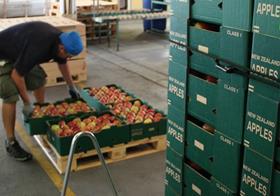
Tariff expenditure on New Zealand fresh produce exports has fallen by 25 per cent to NZ$181m (US$138m) over the last two years, according to a report prepared by Wellington-based company Market Access Solutionz.
Horticulture New Zealand (HortNZ) chief executive Peter Silcock said the performance was testament to New Zealand’s ability to reach free trade agreements (FTA’s) with several key trading partners.
“With New Zealand’s FTA’s being predominantly in the Asian region where high tariffs are common, this progress on tariff reduction enhances the great opportunities for developing trade in Asian countries,” Silcock said. “That’s why we need to continue our efforts on developing and signing free trade agreements.”
The report highlighted that New Zealand’s 2556 kiwifruit growers have paid an average of NZ$29,000 (US$ 22,265) in tariffs each, with a 45 per cent tariff imposed by South Korea costing the industry NZ$20m (US$15m) alone.
A 27 per cent tariff on buttercup squash exports into South Korea has also proven costly for New Zealand growers, who paid a total of NZ$3.9m (US$2.9m) to access markets over the two year period.
However, trade conditions between the two nations are expected to improve over the next decade, with the New Zealand Government announcing that it had reached terms for an FTA with their South Korean counterparts.
The New Zealand Horticulture Export Authority (HEA) and Horticulture New Zealand commissions the report every two years, with funding support from the Ministry of Foreign Affairs and Trade.
As in the previous 2010 and 2012 editions, chief executive Simon Hegarty said there was a notable trend for many importing countries to exploit the use of non-tariff trade barriers (NTBs), in the form of sanitary and phytosanitary (SPS) issues, and other technical compliance barriers.
“This NTB threat remains a concern to our horticulture export sectors,” Hegarty said. “Unfortunately, reality tells us a reasoned case backed by sound science rarely prevails when up against politically motivated decision making. It is important that exporters and government jointly recognise this risk to their business and appropriately resource it to deal with the importing country requirements.”



